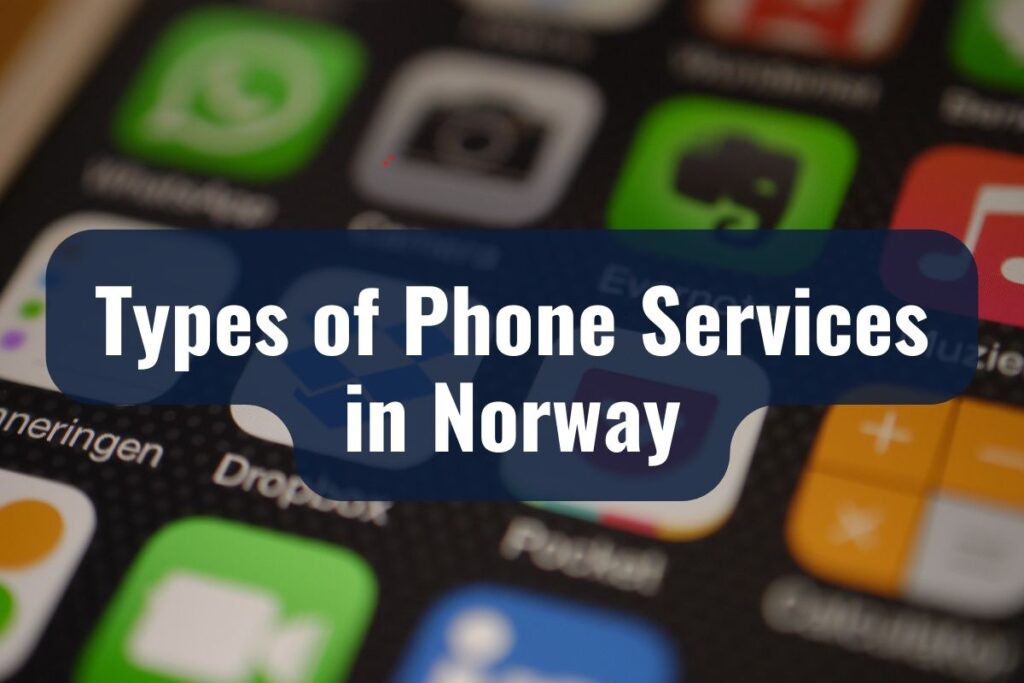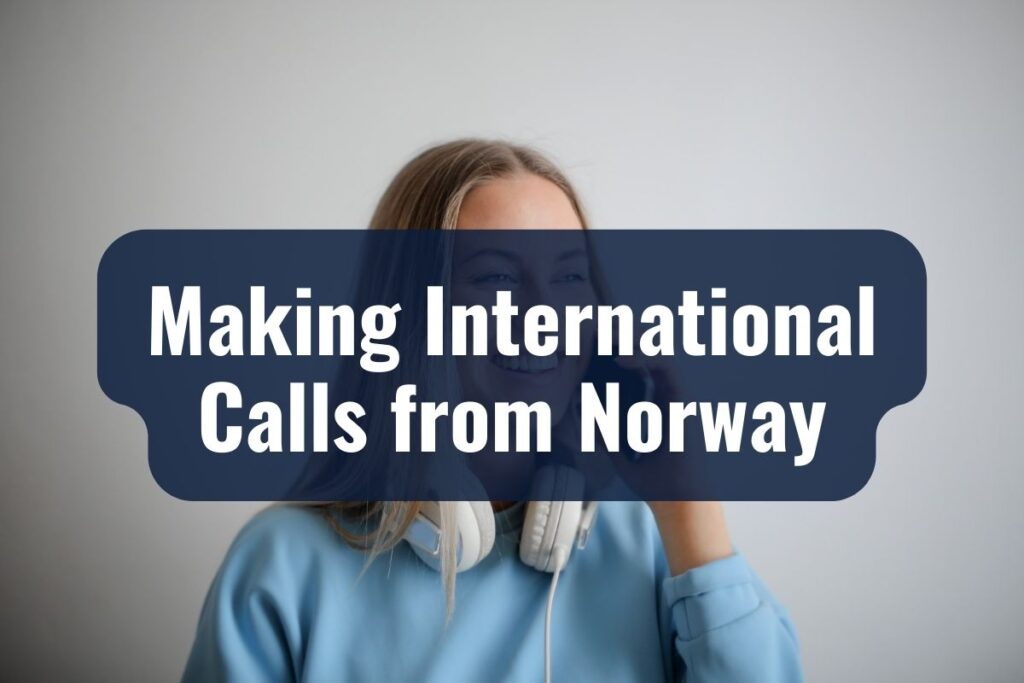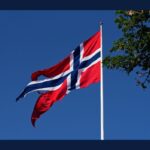Whether you’re an expat, a student, or a long-term tourist, making and receiving phone calls is a crucial part of daily life. It’s how you stay in touch with loved ones back home, coordinate with colleagues, and even handle some bureaucratic tasks that come with living in Norway.
In this article, we’ll take a practical look at everything you need to know about making calls to and from Norway.
Key Takeaways
- Norway’s country code is +47, essential for making international calls to and from the country.
- Understanding the types of phone services in Norway helps you choose the most cost-effective option.
- Making international calls from Norway can be expensive, so consider alternatives like internet-based services.
- Always be prepared with emergency numbers (112 for general emergencies, 110 for fire, 113 for medical).
- Use free internet-based services like WhatsApp and Skype to make calls while connected to Wi-Fi to save on costs.
Understanding the Country Code and Dialing Codes
Knowing the correct codes is the first step in making any call, whether you’re dialing into Norway or reaching out to another country from within its borders. Here, we’ll break down the essential numbers you’ll need to be aware of.
Country Code for Norway: +47
The country code for Norway is +47. When dialing into Norway from abroad, this is the code you will prepend before the local number. The format typically looks like this:
+47 [Local Number]
Area Codes for Major Cities
While Norway doesn’t have a complicated system of area codes for its cities, it is crucial to dial the correct series of numbers when making a local call. For instance, landlines often start with a particular series of numbers that differ from mobile phones.
Here are some initial numbers often associated with major cities:
- Oslo: Usually starts with 22 or 21 (for mobile)
- Bergen: Usually starts with 55 or 9x (for mobile)
- Trondheim: Usually starts with 73 or 4x (for mobile)
Important: Omitting Leading Zeros
When calling Norway from abroad, make sure to omit any leading zeros from the area or mobile prefix. For example, if the local number is 021 123 456, you would dial it as +47 21 123 456.
By understanding these codes and how they work, you’re already on your way to making successful calls while in Norway or to someone residing in this beautiful Nordic country.
Types of Phone Services in Norway

Navigating through different types of phone services can feel like a maze. However, the landscape is fairly straightforward once you get the hang of it. Let’s delve into the types of phone services available in Norway and some practical tips to guide your choices.
Landline Services
Landlines are less popular among individuals these days, but they’re still prevalent in Norwegian homes and businesses. They offer stable connections but may not be the most cost-effective option for international calls. The main landline providers are Telenor, Telio and NexGenTel
Mobile Networks
Mobile services are more versatile and are typically the go-to option for most people, especially if you’re always on the move. The Major Mobile Operators are Telenor, Telia, and Ice.net.
Choosing the Right Plan
Contract: Monthly plans usually offer better deals on data and calls but require a longer commitment.
Pay-as-you-go: This option allows greater flexibility but may have higher per-minute charges.
Look out for special deals and promotions. Often, these packages offer better terms for international calls or data usage.
VoIP Services
VoIP (Voice over Internet Protocol) services like Skype, Zoom, and WhatsApp offer the advantage of making calls over the Internet. These are particularly useful for international calls and are usually cheaper or even free if both parties are using the same service.
Common VoIP Options:
- Skype
- Zoom
- Viber
Cost-Saving Tip: Use VoIP services over a Wi-Fi network to avoid consuming mobile data, which can quickly become expensive.
Picking the Right Service for You

Selecting a phone service that fits your needs isn’t just about convenience; it’s also about cost efficiency. The last thing you want is to be saddled with exorbitant bills because you didn’t anticipate your actual calling needs.
Contract vs. Pay-as-you-go
These are the two primary options when it comes to mobile services. Each has its pros and cons, depending on your situation.
Contract Plans
Pros: Often cheaper in the long run, better deals on data packages, more cost-effective for frequent calls.
Cons: Longer commitment period, possible early termination fees, may require a Norwegian bank account or credit history.
If you’re in Norway for an extended period, a contract could offer you savings on local and international calls. However, read the fine print carefully for any extra fees or limitations.
Pay-as-you-go Plans
Pros: No long-term commitment; more control over spending; easier to set up.
Cons: Generally higher costs for data and per-minute calling; frequent top-ups are required.
Cost-Saving Tip: If you’re a short-term visitor or don’t plan to make many calls, pay-as-you-go could be a flexible and hassle-free option.
Assessing Your Calling Patterns
Before choosing a plan, evaluate how you intend to use your phone service:
- Local Calls: Will you be making many local calls for work or socializing?
- International Calls: How frequently do you plan to call abroad?
- Data Usage: Will you use your phone for browsing, emails, or even as a GPS navigator?
Special Packages and Add-ons
Many providers offer special add-ons or packages that include a set number of international minutes or extra data. These can be a cost-efficient way to get the most out of your service.
Keep an eye on seasonal promotions or special deals for newcomers. Sometimes you can lock in a discounted rate for a set period.
International Calls to Norway
Whether it’s family, friends, or colleagues trying to reach you, or you guiding someone on how to call you in Norway, understanding the mechanics and costs of international calls to Norway is essential.
Related: New To Norway: Embracing Life in Norway
How to Make an International Call to Norway
The formula for making an international call to Norway is generally straightforward:
- Dial the International Dialing Code: This is usually + or 00, depending on the country you’re calling from.
- Dial Norway’s Country Code: This is +47.
- Dial the Local Number: Remember to omit any leading zeros.
So, if the local number is 021 123 456, the number to dial would be +[International Dialing Code] 47 21 123 456.
Costs to Consider
International calls can be expensive, but knowing what you’re in for can save you from an unpleasant surprise.
- Service Provider Rates: Different providers have different rates for international calls, so it’s good to know these in advance.
- Time of Call: Some providers offer reduced rates during off-peak hours.
- Connection Fees: Some services charge a one-time fee to connect the call, in addition to per-minute rates.
Check if your service provider offers international calling packages or if there are any special promotions for calls to Norway.
Alternative Methods
Traditional methods of calling can be pricey, but you’re not limited to them.
Calling Cards: These are prepaid cards that offer a certain number of minutes for a fixed price. They can be a cost-effective option for making international calls.
VoIP Services: Skype, WhatsApp, and similar apps often offer cheaper rates for international calls. Plus, if both parties are using the app, the call is usually free.
Making International Calls from Norway

Whether you’re calling family back home, scheduling a teleconference for work, or just catching up with friends, making international calls from Norway is a reality for many expats, students, and long-term tourists.
Steps to Make International Calls
Making an international call from Norway is pretty straightforward, but here’s the typical formula you’ll follow:
- Dial the International Exit Code: For calls originating from Norway, this is 00.
- Dial the Country Code: Every country has its own country code. For instance, the United States is +1, the United Kingdom is +44, etc.
- Dial the Local Number: Add the local area code and the phone number you are trying to reach.
So, if you are trying to call a number in the United States with a local number of (212) 345-6789, you would dial 00 1 212 345 6789.
How to Find Affordable Options
International calling can become expensive quickly, but there are ways to manage the costs.
- Research Rates: Your mobile provider will have specific rates for different countries. Check these out in advance so you know what to expect on your bill.
- Special Packages: Many mobile network operators offer international calling packages. These can often be added to your regular monthly bill and provide a set number of minutes for a fixed price.
If you make frequent calls to a specific country, check if your service provider offers a country-specific calling package. These are often cheaper than general international packages.
Other Ways to Make International Calls
Traditional phone calls aren’t your only option for international communication. Here are some alternative methods:
VoIP Services: Platforms like Skype, WhatsApp, and Zoom allow you to make calls over the internet, often at a fraction of the cost of a traditional phone call.
Calling Cards: These are still an option and can be bought at kiosks or online. They offer prepaid minutes at fixed rates.
Free Wi-Fi Spots: If you use a VoIP service, doing so over free Wi-Fi can save you from using your own costly mobile data.
Related: Dating Apps in Norway: The 6 Best Norwegian Dating Sites
Roaming Charges
Navigating the maze of roaming charges can be one of the trickiest parts of international travel and relocation. One moment you’re casually browsing the web, and the next, you’re hit with a bill that costs more than your flight ticket.
What are Roaming Charges?
Roaming charges occur when you use your mobile phone outside the network coverage of your original service provider. Essentially, you’re “borrowing” network coverage from a local provider in the country you’re visiting, and this service usually comes at a premium.
How Roaming Applies in Norway
Within the EEA: If you have a SIM card from another country within the European Economic Area (EEA), you’ll generally enjoy “Roam Like at Home” benefits. This means you can use your mobile services in Norway at the same prices you pay in your home country.
Outside the EEA: For those coming from outside the EEA, roaming charges can be considerably higher. It’s crucial to check with your home service provider for rates.
Tips on How to Avoid Hefty Fees
- Switch to a Local SIM Card: If you’re in Norway for an extended period, consider purchasing a local prepaid SIM card. This will generally be much cheaper than roaming, especially for data usage.
- Use Wi-Fi Whenever Possible: Connect to Wi-Fi to make calls, send messages, or use the internet. This way, you avoid using expensive mobile data.
- Turn Off Data Roaming: To avoid unexpected charges, turn off data roaming in your phone’s settings when you’re not using it.
- Monitor Your Usage: Regularly check your data and call usage to ensure you’re not going over any limits or allowances.
- Check for Roaming Packages: Some providers offer roaming packages for travelers, which can reduce the cost of calls, texts, and data usage.
Cost-Saving Tip: If you’re unsure about the roaming rates or your usage, set a data limit on your phone. It will automatically turn off mobile data once you reach this limit, preventing any unexpected costs.
Local Calls
While international calls may be a significant concern for those newly arrived in Norway, understanding how to effectively make local calls is just as vital for daily life. From ordering takeout to booking appointments or simply staying in touch with new friends, knowing the intricacies of local calling can be a lifesaver.
Dialing Procedure for Local Calls
Making a local call in Norway is straightforward. Generally, you can directly dial the seven- or eight-digit local number without needing any additional codes. If you are dialing from a landline to another landline within the same area, sometimes even the area prefix is not necessary.
Example Format: (Area Prefix) + Local Number
Example: 21 123 456
Mobile Calls vs. Landline Calls
Mobile Numbers:
Usually start with a ‘4’, ‘9’, or other numbers depending on the service provider. Mobile numbers typically have eight digits.
Landline Numbers:
Generally, start with a specific two-digit code based on the area or city. For instance, Oslo landline numbers often start with ’22’, Bergen with ’55’, and so on.
Costs Associated with Local Calls
Mobiles:
Charges can depend on your specific plan but usually entail either a flat rate or are included in bundled minutes.
Landlines:
Charges can be based on the time of day and usually are more expensive during business hours. However, many people have shifted towards bundled packages, where calls might be free as part of the bundle.
Cost-Saving Tip: Many local service providers offer unlimited calls and text messages as part of their standard packages, especially for mobile services. If you anticipate making a lot of local calls, this could be a cost-effective option for you.
Voice Services and Automated Systems
One thing to be prepared for is encountering automated voice services when calling businesses or public services. While these systems often offer an English language option, it’s good to be prepared for some navigation through Norwegian prompts.
Emergency Numbers

In a foreign country, knowing how to get help quickly in an emergency is paramount. Whether it’s a medical situation, a fire, or a crime incident, the last thing you want to be doing is scrambling to find the right number to call.
| Emergency Type | Emergency Number | Language Support | Cost |
| General | 112 | English Possible | Free |
| Fire | 110 | English Possible | Free |
| Medical | 113 | English Possible | Free |
| Police | 112 | English Possible | Free |
| Non-Emergency (Police) | 02800 | English Possible | Varies |
Remember, these numbers are for emergencies only. Misuse of emergency numbers can lead to penalties.
Language Barriers in Emergency Situations
Most dispatchers in Norway will have some level of English proficiency, but it’s not guaranteed. If you’re unable to communicate your situation clearly:
Find a Translator: If someone near you speaks both Norwegian and English, ask for their assistance.
Use Basic Terms: Try to use simple and clear English terms to describe your situation. The more straightforward you are, the better.
Location is Key: Always know your address or current location. Being able to communicate this quickly can make all the difference in an emergency.
Using a Mobile Phone for Emergency Calls
If you’re using a mobile phone to call emergency services, be aware that your location may not automatically be shared with the dispatcher, unlike with some landline services.
Cost-Saving Tip: Emergency calls are free from any phone, even mobiles without an active service plan.
Non-Emergency Alternative Numbers
For situations that require attention but are not immediate emergencies, you can dial:
Police Non-Emergency: 02800
These numbers can also offer English-speaking assistance, although it’s less guaranteed compared to emergency lines.
Additional Services
Beyond the regular calls, international connections, and emergency numbers, there are other services that can be highly beneficial for expats, students, and long-term tourists in Norway. These can range from directory services to helplines and toll-free numbers.
Directory Services
If you’re looking to find a specific business or even a residential phone number, directory services can be quite useful.
- Yellow Pages: Known as “Gule Sider” in Norway, this is your go-to for finding business contacts.
- White Pages: For private numbers, though it’s used less commonly than the Yellow Pages.
These directories are often available online and have English language options.
Helplines and Information Services
Several helplines operate in Norway, offering various forms of assistance.
Tourist Information: Typically available in bigger cities, these lines can offer you guidance on accommodation, transportation, and local events.
Public Transport Helplines: Useful for understanding timetables, routes, and prices for buses, trams, and trains.
Healthcare Helplines: If you have a non-emergency medical issue, these helplines can offer advice and guide you to the nearest appropriate facility.
Toll-Free and Special Numbers
You may also encounter special numbers for services that are either free or charged at a different rate than standard calls.
Toll-Free Numbers: Usually start with ‘800’ and are free to call. However, be cautious when dialing these from a mobile as some providers may still charge you.
Special Rates: Numbers starting with ‘815’ or ‘820’ often have special rates, usually higher than normal calls.
Cost-Saving Tip: Always double-check with your service provider about the charges for these special numbers, especially if you plan to use them frequently.
Voice Mail Services
Voice mail is generally offered by all major carriers in Norway. It’s advisable to set up your voicemail in English if you expect to receive messages from people who may not speak Norwegian.
Free Ways to Stay Connected
- WhatsApp: This service allows free text, voice, and video calls. The only requirement is an internet connection.
- Skype: A pioneer in VoIP services, Skype offers free video and voice calls to other Skype users and also provides affordable international calling options.
- Zoom: Particularly popular for professional meetings, Zoom’s free tier allows unlimited one-on-one video calling and 40-minute limits on group calls.
Cost-Saving Tip: Always try to use these services when connected to Wi-Fi to avoid using your mobile data, which could result in extra charges.
- Facebook Messenger: Provides free voice and video calling to your Facebook friends.
- Instagram Direct: You can make free one-on-one or group video calls through Instagram’s messaging feature.
FAQs
What is Norway’s Country Code?
Norway’s country code is +47. You’ll need to use this when calling into Norway from abroad.
Can I Use My Home Country Mobile SIM in Norway?
Yes, but you may be subject to high roaming charges. To avoid this, you can opt for a local SIM card or use Wi-Fi for internet-based calling.
How Do I Make Local Calls in Norway?
Local calls usually require dialing a seven or eight-digit number. No country or area codes are necessary unless you’re calling from outside the region.
Are Emergency Calls Free?
Yes, emergency calls to numbers like 112 (general emergency) or 113 (medical help) are free from any phone, even mobiles without an active service plan.
How Can I Avoid High Roaming Charges?
To avoid high roaming charges, you can:
Switch to a local SIM card
Use Wi-Fi for calls and internet
Turn off data roaming in your phone settings
Do Public Phones Still Exist in Norway?
Public phones are rare but they do exist, primarily in some transport hubs and rural areas. They accept coins or prepaid cards.
Are Directory Services Free?
Generally, directory services like the Yellow Pages (“Gule Sider”) and White Pages are available online for free, but calling a directory service number may come with a fee.
Can I Dial Toll-Free Numbers from Any Phone?
Toll-free numbers usually start with ‘800’ and are generally free to call from landlines, but charges may apply if you’re calling from a mobile phone.
Is Text Messaging Popular in Norway?
Yes, text messaging is commonly used, although many people prefer using internet-based messaging apps like WhatsApp for both local and international communication.


